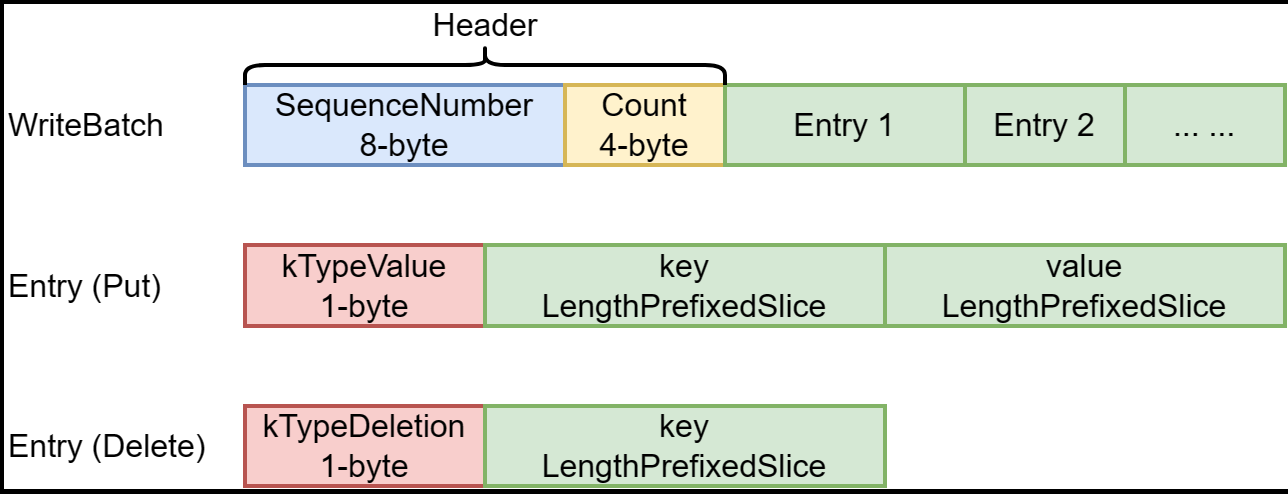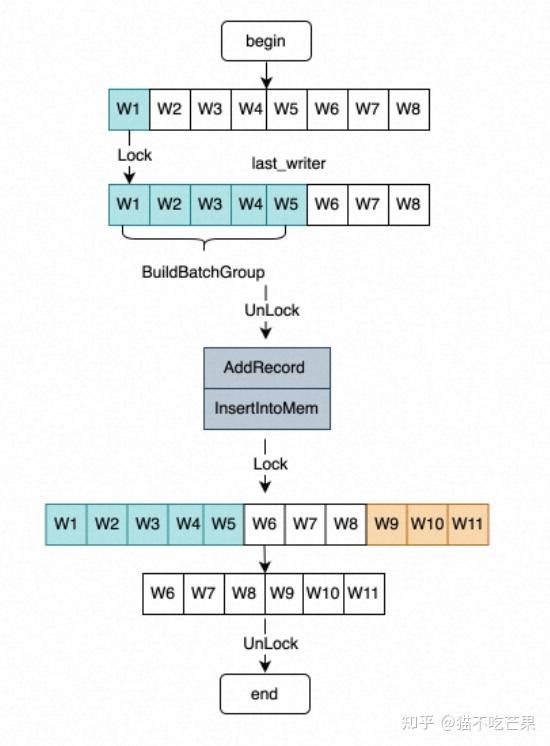Put && Delete && Get
这篇文章主要介绍一下leveldb中Put 和Delete 的接口。而Write接口用来批量执行Put或Delete操作,在同一批(即同一个WriteBatch)中的操作,其插入的entry的SequenceNumber相同。
1
2
3
4
5
6
7
8
9
10
11
| Status DB::Put(const WriteOptions& opt, const Slice& key, const Slice& value) {
WriteBatch batch;
batch.Put(key, value);
return Write(opt, &batch);
}
Status DB::Delete(const WriteOptions& opt, const Slice& key) {
WriteBatch batch;
batch.Delete(key);
return Write(opt, &batch);
}
|
WriteBatch
WriteBatch是用来记录需要批处理的若干个Put或Delete操作的结构体。LevelDB会为同一个WriteBatch中所有操作分配相同的SequenceNumber。WriteBatch的结构如下图所示:

每个WriteBatch在内存中是一个连续的字节数组,其头12个字节是WriteBatch的Header,其中前8字节是该WriteBatch的SequenceNumber,后4字节是该WriteBatch中Entry的数量。Header后面连续存放着WriteBatch中的Entry。每个Entry的头一个字节标识了该Entry的操作类型。对于Put操作的Entry,在类型标识后以LengthPrefixedSlice编码存放着key和value;对于Delete操作的Entry,在类型标识后以LengthPrefixedSlice编码存放着待删除忽的key。
WriteBatch 的用法如下:
1
2
3
4
5
| leveldb::WriteBatch batch;
batch.Put(key1, value1);
batch.Delete(key1);
batch.Put(key2, value);
s = db->Write(leveldb::WriteOptions(), &batch);
|
为了优化写性能,LevelDB中提供了写合并能力,队首线程可以将队列中多个连续的写任务合并为一个写任务。
- 若队首写任务的WriteOption中sync属性为false且待合并的任务sync属性为true,则不能被合并。如下图中假设W1、W2、W3、W4、W5的sync属性为false,W6的sync属性为true,则W1~5将被合并为一个写任务,随后开始写日志文件(AddRecord)和写内存数据库(InsertIntoMemtable)。
- 写日志和内存数据库时会释放写锁,允许其他线程向写队列中添加写任务,当写任务完成时将再次加锁,并更新当前版本的操作序列号(更新前的序列号加上本次写任务的写操作数量)。
- 当前写任务完成时,写队列中可能被其他线程插入了新的任务(W9~11),已完成的写任务将陆续出队列,最后唤醒当前队首线程(W6)进行新一轮的写任务。

我们来看相关的代码:
1
2
3
4
5
6
7
8
9
10
11
12
13
14
15
16
17
18
19
20
21
22
23
24
25
26
27
28
29
30
31
32
33
34
35
36
37
38
39
40
41
42
43
44
45
46
47
48
49
50
51
52
53
54
55
56
57
58
59
60
61
62
63
64
65
66
67
68
69
70
71
72
73
74
75
| Status DBImpl::Write(const WriteOptions& options, WriteBatch* updates) {
Writer w(&mutex_);
w.batch = updates;
w.sync = options.sync;
w.done = false;
MutexLock l(&mutex_);
writers_.push_back(&w);
while (!w.done && &w != writers_.front()) {
w.cv.Wait();
}
if (w.done) {
return w.status;
}
Status status = MakeRoomForWrite(updates == nullptr);
uint64_t last_sequence = versions_->LastSequence();
Writer* last_writer = &w;
if (status.ok() && updates != nullptr) {
WriteBatch* write_batch = BuildBatchGroup(&last_writer);
WriteBatchInternal::SetSequence(write_batch, last_sequence + 1);
last_sequence += WriteBatchInternal::Count(write_batch);
{
mutex_.Unlock();
status = log_->AddRecord(WriteBatchInternal::Contents(write_batch));
bool sync_error = false;
if (status.ok() && options.sync) {
status = logfile_->Sync();
if (!status.ok()) {
sync_error = true;
}
}
if (status.ok()) {
status = WriteBatchInternal::InsertInto(write_batch, mem_);
}
mutex_.Lock();
}
versions_->SetLastSequence(last_sequence);
}
while (true) {
Writer* ready = writers_.front();
writers_.pop_front();
if (ready != &w) {
ready->status = status;
ready->done = true;
ready->cv.Signal();
}
if (ready == last_writer) break;
}
if (!writers_.empty()) {
writers_.front()->cv.Signal();
}
return status;
}
|
Get操作
首先这里为mutex_ 进行加锁,为什么需要MutexLock 类?
这里利用了析构函数对mutex_进行解锁的,退出这个函数的作用域就会调用MutexLock析构函数,不会出现忘记解锁导致的问题。这种机制也叫作RALL(Resource Acquisition Is Initialization)。
然后从options 里面获取快照信息。
然后获取mem_ 、imm_ 和current_ ,将依次在这里面进行查询。
1
2
3
4
5
6
7
8
9
10
11
12
13
14
15
16
| Status s;
MutexLock l(&mutex_);
SequenceNumber snapshot;
if (options.snapshot != nullptr) {
snapshot =
static_cast<const SnapshotImpl*>(options.snapshot)->sequence_number();
} else {
snapshot = versions_->LastSequence();
}
MemTable* mem = mem_;
MemTable* imm = imm_;
Version* current = versions_->current();
mem->Ref();
if (imm != nullptr) imm->Ref();
current->Ref();
|
然后构造LookupKey ,在三个层次中进行查询就可以了。
1
2
3
4
5
6
7
8
9
10
11
12
13
14
15
16
17
18
19
20
21
22
23
24
25
26
| bool have_stat_update = false;
Version::GetStats stats;
{
mutex_.Unlock();
LookupKey lkey(key, snapshot);
if (mem->Get(lkey, value, &s)) {
} else if (imm != nullptr && imm->Get(lkey, value, &s)) {
} else {
s = current->Get(options, lkey, value, &stats);
have_stat_update = true;
}
mutex_.Lock();
}
if (have_stat_update && current->UpdateStats(stats)) {
MaybeScheduleCompaction();
}
mem->Unref();
if (imm != nullptr) imm->Unref();
current->Unref();
return s;
|

